Evaluation of the Turbulence Model Influence on the Numerical Simulation of Cavitating Flow with Emphasis on Temperature Effect
Abstract
:1. Introduction
2. Mathematical Formation
2.1. Governing Equations
2.2. Turbulence Model
2.2.1. Turbulence Model
2.2.2. RNG Turbulence Model
2.2.3. SST Turbulence Model
2.2.4. Modification of Turbulence Model
2.3. Cavitation Model for Thermosensitive Fluids
3. Numerical Setup and Validation
3.1. NACA0015 Hydrofoil Geometry Model
3.2. Mesh Implementation
3.3. Boundary Conditions
3.4. Mesh Independence Study
4. Results and Discussion
4.1. Influence of Different Turbulence Models on NACA0015 at 25 °C
4.2. Influence of Different Turbulence Models on NACA0015 at 50 °C
4.3. Influence of Different Turbulence Models on NACA0015 at 70 °C
4.4. Influence of Modified RNG k-ε Model on NACA0015 Hydrofoil at Different Temperatures
5. Conclusions
- (1)
- At 25 °C, the correction effect is significant for the modified k-ε model, and the vortex is eliminated in the closed area of the cavity tail. The simulation results obtained from the modified RNG k-ε model and the SST k-ω model showed reasonably good agreement with the experimental results.
- (2)
- At 50 °C, the modified RNG k-ε model and the modified SST k-ω model have a small difference between numerical results and experimental results for the RMS error and the maximum deviation.
- (3)
- At 70 °C, the modified RNG k-ε model is smaller than the result of the modified SST k-ω model in terms of the RMS error and the maximum deviation. The turbulent kinetic energy of the modified SST k-ω model near the wall is significantly larger than that obtained by the modified RNG k-ε model, and the cavitation is more serious, which is quite different from the experimental results.
- (4)
- The feasibility of the modified RNG k-ε turbulence model is demonstrated using this model to simulate cavitating flow around the NACA0015 hydrofoil at different temperatures of water.
Author Contributions
Funding
Acknowledgments
Conflicts of Interest
References
- Wang, Y.; Zhang, M.; Chen, T.; Huang, B. Effects of thermodynamic on unsteady cavitation flow of liquid hydrogen. Hangkong Dongli Xuebao/J. Aerosp. Power 2018, 33, 2866–2876. [Google Scholar] [CrossRef]
- Liu, H.; Zhang, T.; Kang, C. Evaluation of cavitation erosion resistance of copper alloy in different liquid media. Mater. Corros. 2018, 69, 917–925. [Google Scholar] [CrossRef]
- Bai, L.; Zhou, L.; Jiang, X.; Pang, Q.; Ye, D. Vibration in a Multistage Centrifugal Pump under Varied Conditions. Shock Vib. 2019, 2019, 2057031. [Google Scholar] [CrossRef]
- Wang, L.; Liu, H.; Wang, K.; Zhou, L.; Jiang, X.; Li, Y. Numerical simulation of the sound field of a five-stage centrifugal pump with different turbulence models. Water 2019, 11, 1777. [Google Scholar] [CrossRef] [Green Version]
- Watanabe, S.; Hidaka, T.; Horiguchi, H.; Furukawa, A.; Tsujimoto, Y. Analysis of thermodynamic effects on cavitation instabilities. J. Fluids Eng. Trans. ASME 2007, 129, 1123–1130. [Google Scholar] [CrossRef]
- Wang, D.-X.; Naranmandula. Theoretical study of coupling double-bubbles ultrasonic cavitation characteristics. Wuli Xuebao/Acta Phys. Sin. 2018, 67, 037802. [Google Scholar] [CrossRef]
- Wang, S.; Zhu, J.; Xie, H.; Zhang, F.; Zhang, X. Studies on thermal effects of cavitation in LN2 flow over a twisted hydrofoil based on large eddy simulation. Cryogenics 2019, 97, 40–49. [Google Scholar] [CrossRef]
- Zhang, W.; Li, X.; Zhu, Z. Quantification of wake unsteadiness for low-Re flow across two staggered cylinders. Proc. Inst. Mech. Eng. Part C 2019, 233, 6892–6909. [Google Scholar] [CrossRef]
- Zhang, S.; Li, X.; Hu, B.; Liu, Y.; Zhu, Z. Numerical investigation of attached cavitating flow in thermo-sensitive fluid with special emphasis on thermal effect and shedding dynamics. Int. J. Hydrog. Energy 2019, 44, 3170–3184. [Google Scholar] [CrossRef]
- Li, X.; Li, B.; Yu, B.; Ren, Y.; Chen, B. Calculation of cavitation evolution and associated turbulent kinetic energy transport around a NACA66 hydrofoil. J. Mech. Sci. Technol. 2019, 33, 1231–1241. [Google Scholar] [CrossRef]
- Chang, H.; Xie, X.; Zheng, Y.; Shu, S. Numerical study on the cavitating flow in liquid hydrogen through elbow pipes with a simplified cavitation model. Int. J. Hydrog. Energy 2017, 42, 18325–18332. [Google Scholar] [CrossRef]
- Jin, T.; Tian, H.; Gao, X.; Liu, Y.; Wang, J.; Chen, H.; Lan, Y. Simulation and performance analysis of the perforated plate flowmeter for liquid hydrogen. Int. J. Hydrog. Energy 2017, 42, 3890–3898. [Google Scholar] [CrossRef]
- Hord, J. Cavitation in Liquid Cryogens-2. Hydrofoil; NASA Contractor Reports, (CR-2156); National Bureau of Standards: Boulder, CO, USA, 1973.
- Hord, J. Cavitation in Liquid Cryogens-3. Ogives; NASA Contractor Reports, (CR-2242); National Bureau of Standards: Boulder, CO, USA, 1973.
- Xu, B.; Feng, J.; Wan, F.; Zhang, D.; Shen, X.; Zhang, W. Numerical investigation of modified cavitation model with thermodynamic effect in water and liquid nitrogen. Cryogenics 2020, 106, 103049. [Google Scholar] [CrossRef]
- Christopher, N.; Peter, J.M.F.; Kloker, M.J.; Hickey, J.-P. DNS of turbulent flat-plate flow with transpiration cooling. Int. J. Heat Mass Transf. 2020, 157, 119972. [Google Scholar] [CrossRef]
- Noormohammadi, A.; Wang, B.-C. DNS study of passive plume interference emitting from two parallel line sources in a turbulent channel flow. Int. J. Heat Fluid Flow 2019, 77, 202–216. [Google Scholar] [CrossRef]
- Alfonsi, G.; Ferraro, D.; Lauria, A.; Gaudio, R. Large-eddy simulation of turbulent natural-bed flow. Phys. Fluids 2019, 31, 085105. [Google Scholar] [CrossRef]
- Hu, W.-C.; Yang, Q.-S.; Zhang, J. Les study of turbulent boundary layers over three-dimensional hills. Gongcheng Lixue/Eng. Mech. 2019, 36, 72–79. [Google Scholar] [CrossRef]
- Cheng, H.Y.; Bai, X.R.; Long, X.P.; Ji, B.; Peng, X.X.; Farhat, M. Large eddy simulation of the tip-leakage cavitating flow with an insight on how cavitation influences vorticity and turbulence. Appl. Math. Model. 2020, 77, 788–809. [Google Scholar] [CrossRef]
- Ghorbani, M.; Yildiz, M.; Gozuacik, D.; Kosar, A. Cavitating nozzle flows in micro- and minichannels under the effect of turbulence. J. Mech. Sci. Technol. 2016, 30, 2565–2581. [Google Scholar] [CrossRef]
- Miltner, M.; Jordan, C.; Harasek, M. CFD simulation of straight and slightly swirling turbulent free jets using different RANS-turbulence models. Appl. Therm. Eng. 2015, 89, 1117–1126. [Google Scholar] [CrossRef]
- You, B.-H.; Jeong, Y.H.; Addad, Y. RANS simulation of turbulent swept flow over a wire in a channel for core thermal hydraulic design using K-Epsilon turbulence models. In Proceedings of the 16th International Topical Meeting on Nuclear Reactor Thermal Hydraulics (NURETH 2015), Chicago, IL, USA, 30 August–4 September 2015; pp. 2972–2983. [Google Scholar]
- Liu, T.-T.; Wang, G.-Y.; Duan, L. Assessment of a modified turbulence model based experiment results for ventilated supercavity. Beijing Ligong Daxue Xuebao/Trans. Beijing Inst. Technol. 2016, 36, 247–251. [Google Scholar] [CrossRef]
- Sun, L.G.; Guo, P.C.; Zheng, X.B.; Yan, J.G.; Feng, J.J.; Luo, X.Q. Numerical investigation into cavitating flow around a NACA66 hydrofoil with DCM models. In Proceedings of the 29th IAHR Symposium on Hydraulic Machinery and Systems (IAHR 2018), Kyoto, Japan, 16–21 September 2018. [Google Scholar]
- Gao, Y.; Liu, Q.; Chen, Y. Numerical simulation on cavitating flow around hydrofoil with filter-based turbulence model. Harbin Gongcheng Daxue Xuebao/J. Harbin Eng. Univ. 2013, 34, 92–97. [Google Scholar] [CrossRef]
- Huang, B.; Wang, G.; Zhang, B.; Yu, Z. Evaluation and application of filter based turbulence model for computations of cloud cavitating flows. Jixie Gongcheng Xuebao/J. Mech. Eng. 2010, 46, 147–153. [Google Scholar] [CrossRef]
- Menter, F. Two equation k-turbulence models for aerodynamic flows. In Proceedings of the 23rd Fluid Dynamics, Plasmadynamics, and Lasers Conference, Orlando, FL, USA, 6–9 July 1993; p. 2906. [Google Scholar]
- Merkle, C.L. Computational modelling of the dynamics of sheet cavitation. In Proceedings of the 3rd International Symposium on Cavitation, Grenoble, France, 7–10 April 1998. [Google Scholar]
- Cervone, A.; Bramanti, C.; Rapposelli, E.; D’Agostino, L. Thermal cavitation experiments on a NACA 0015 hydrofoil. J. Fluids Eng. Trans. ASME 2006, 128, 326–331. [Google Scholar] [CrossRef]
- Coates, M.S.; Fletcher, D.F.; Chan, H.-K.; Raper, J.A. Effect of design on the performance of a dry powder inhaler using computational fluid dynamics. Part 1: Grid structure and mouthpiece length. J. Pharm. Sci. 2004, 93, 2863–2876. [Google Scholar] [CrossRef] [PubMed]
- Li, X.; Shen, T.; Li, P.; Guo, X.; Zhu, Z. Extended compressible thermal cavitation model for the numerical simulation of cryogenic cavitating flow. Int. J. Hydrog. Energy. 2020, 45, 10104–10118. [Google Scholar] [CrossRef]


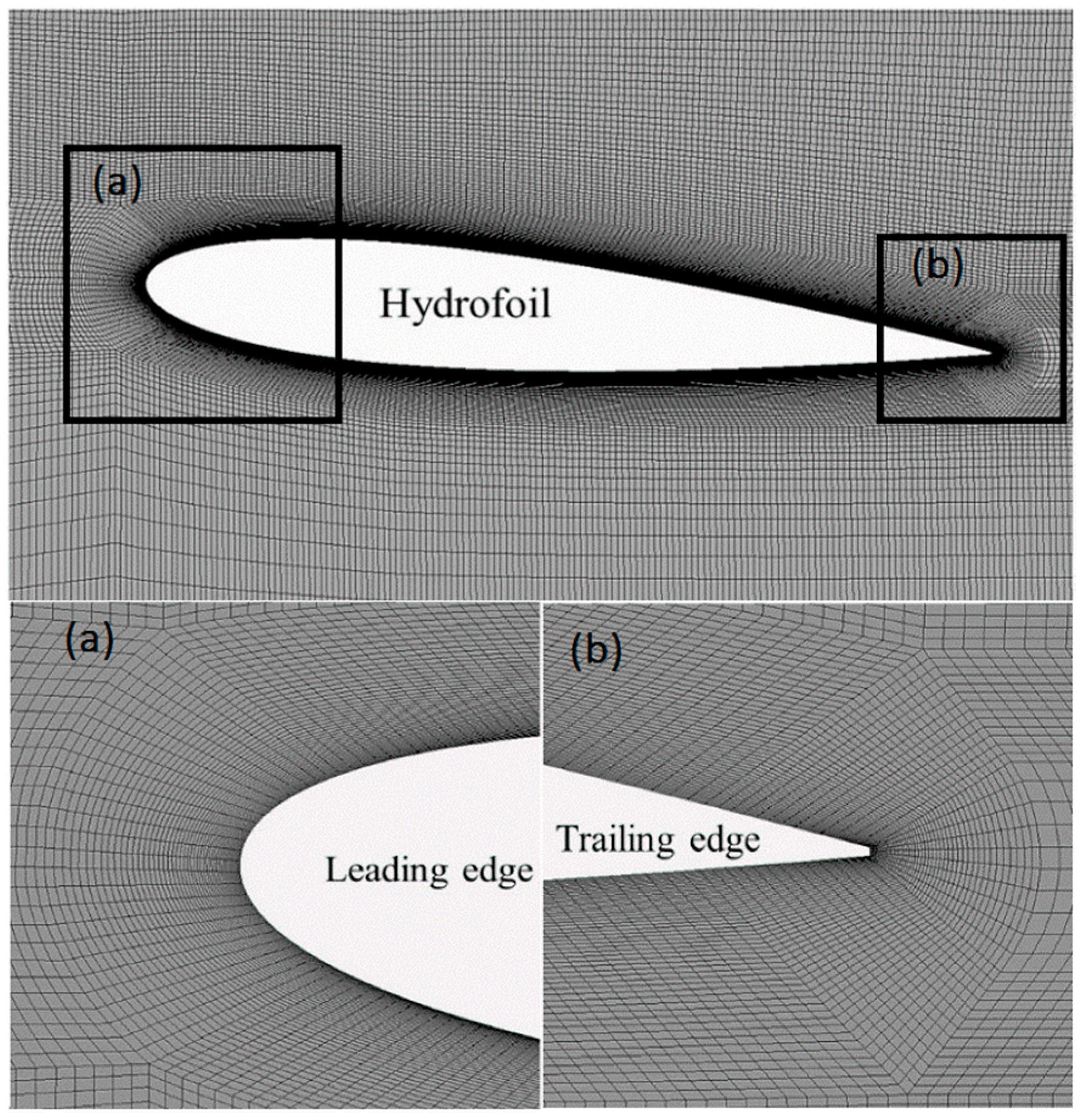


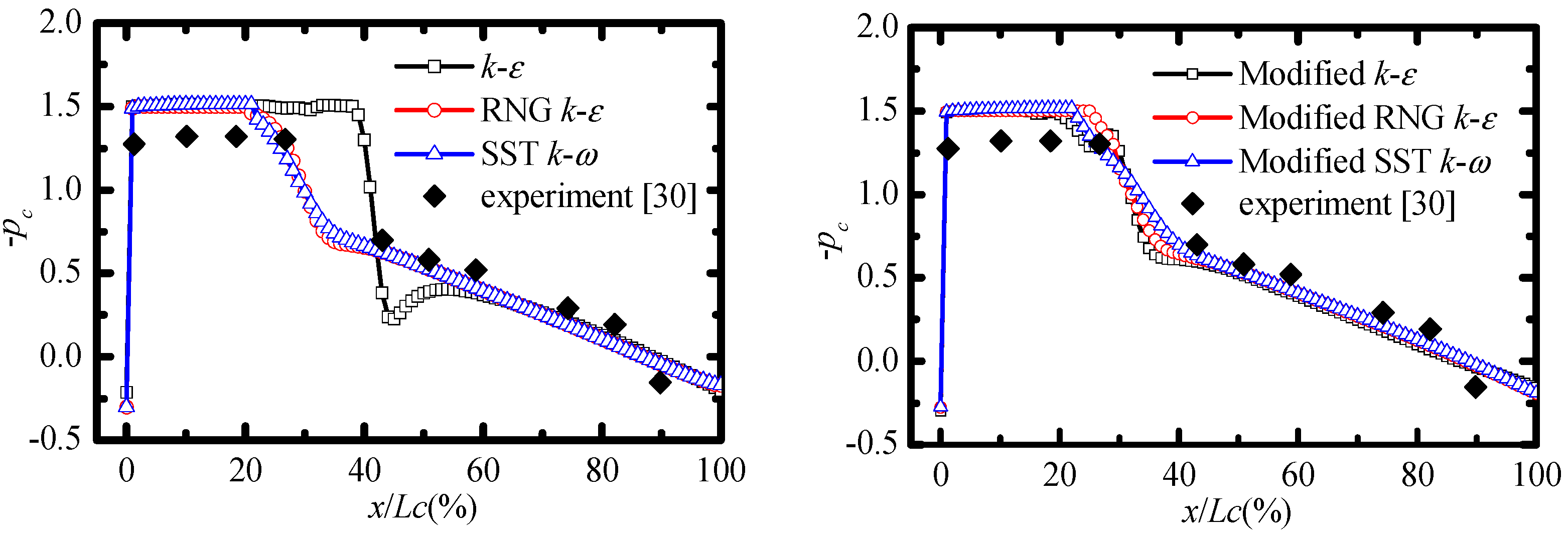
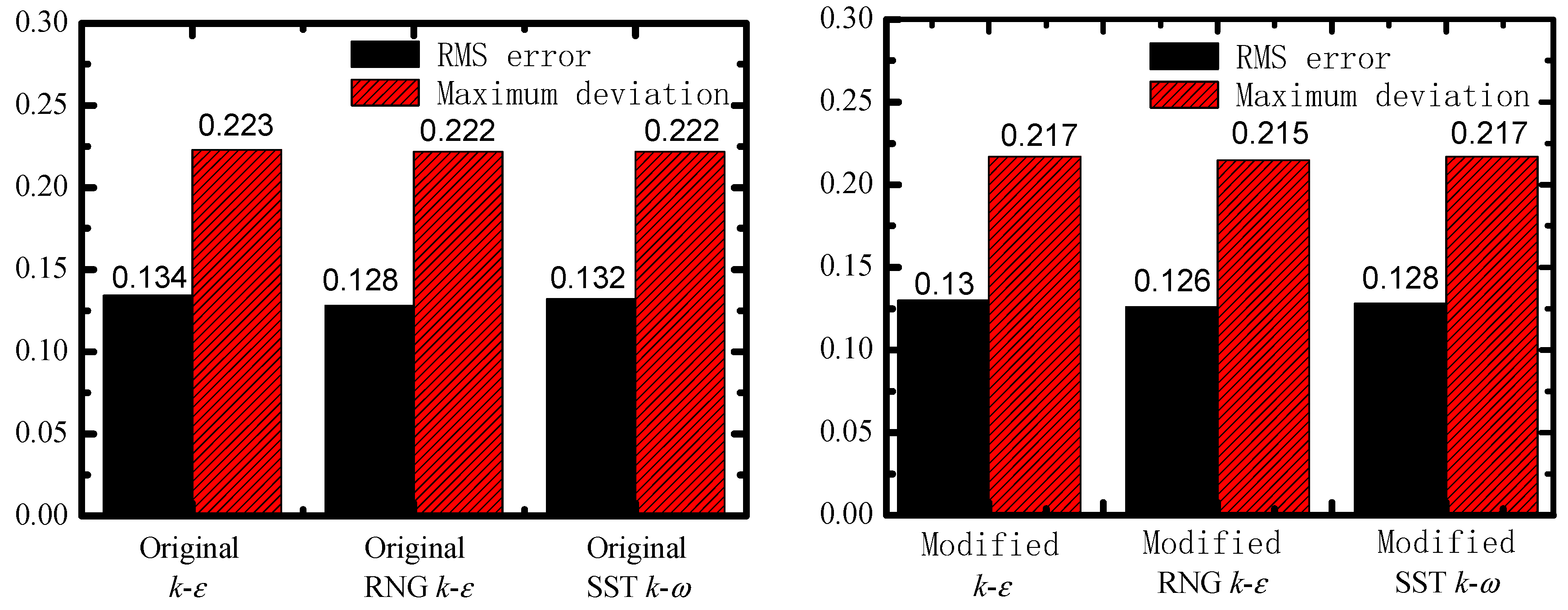


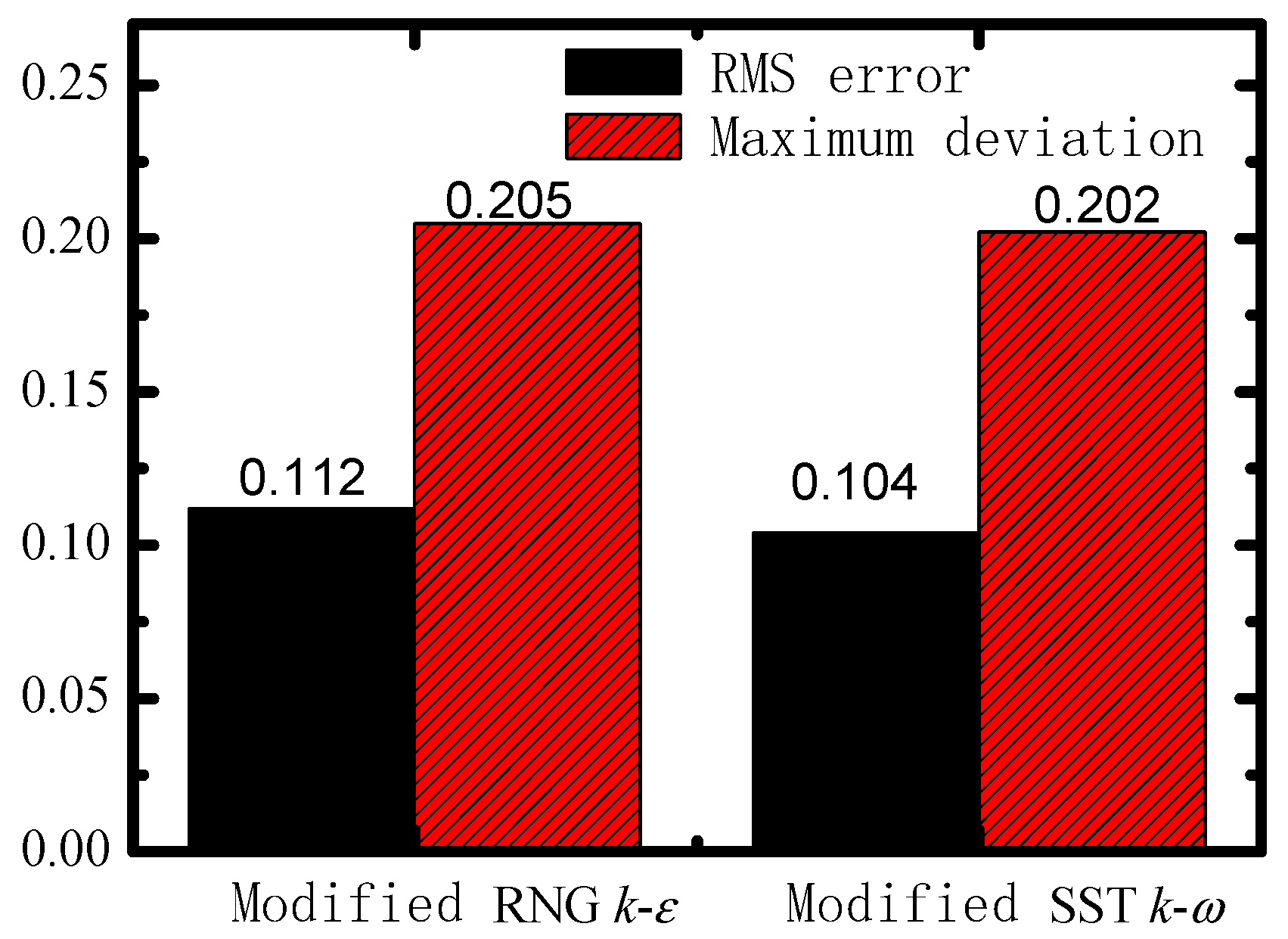
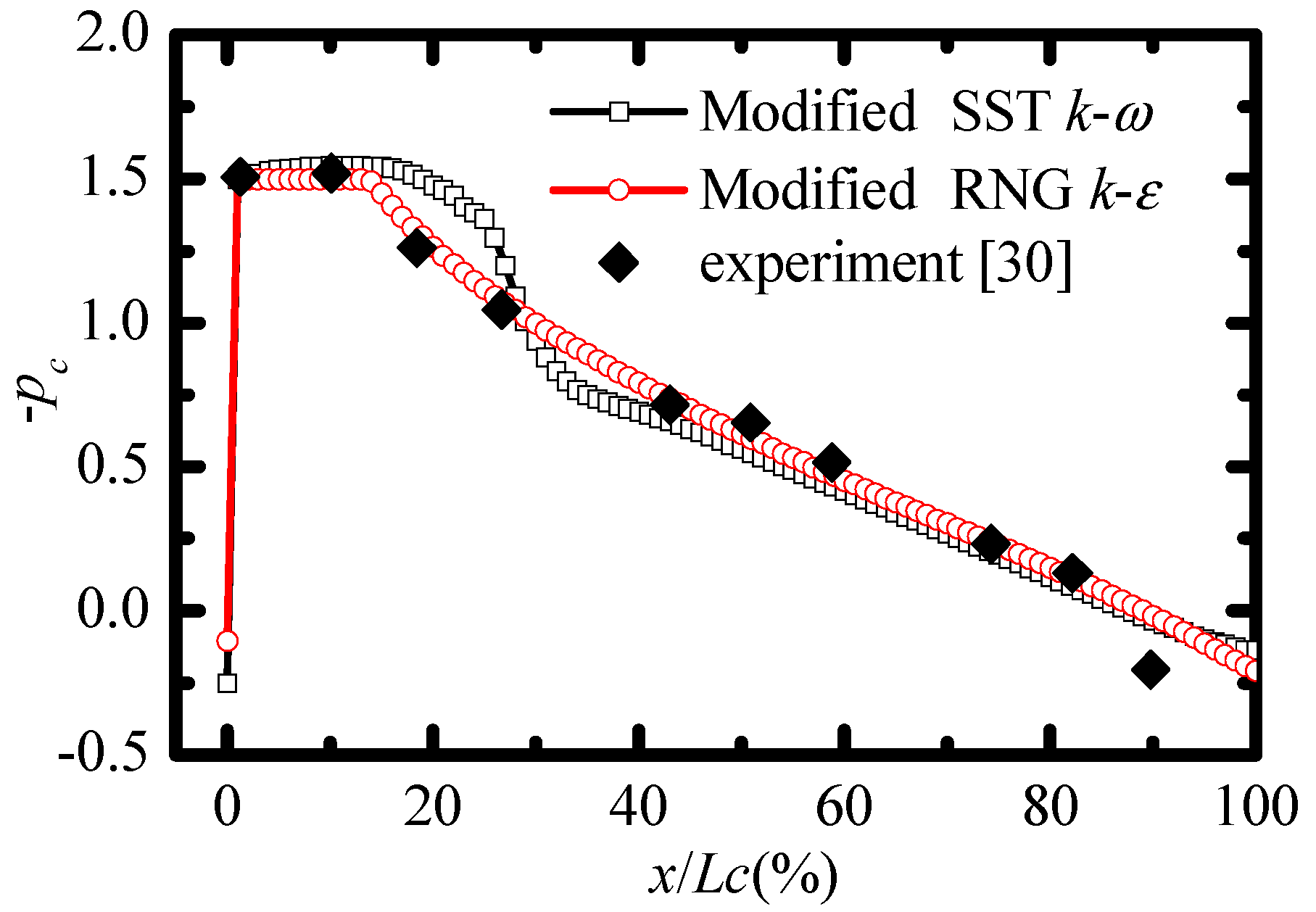
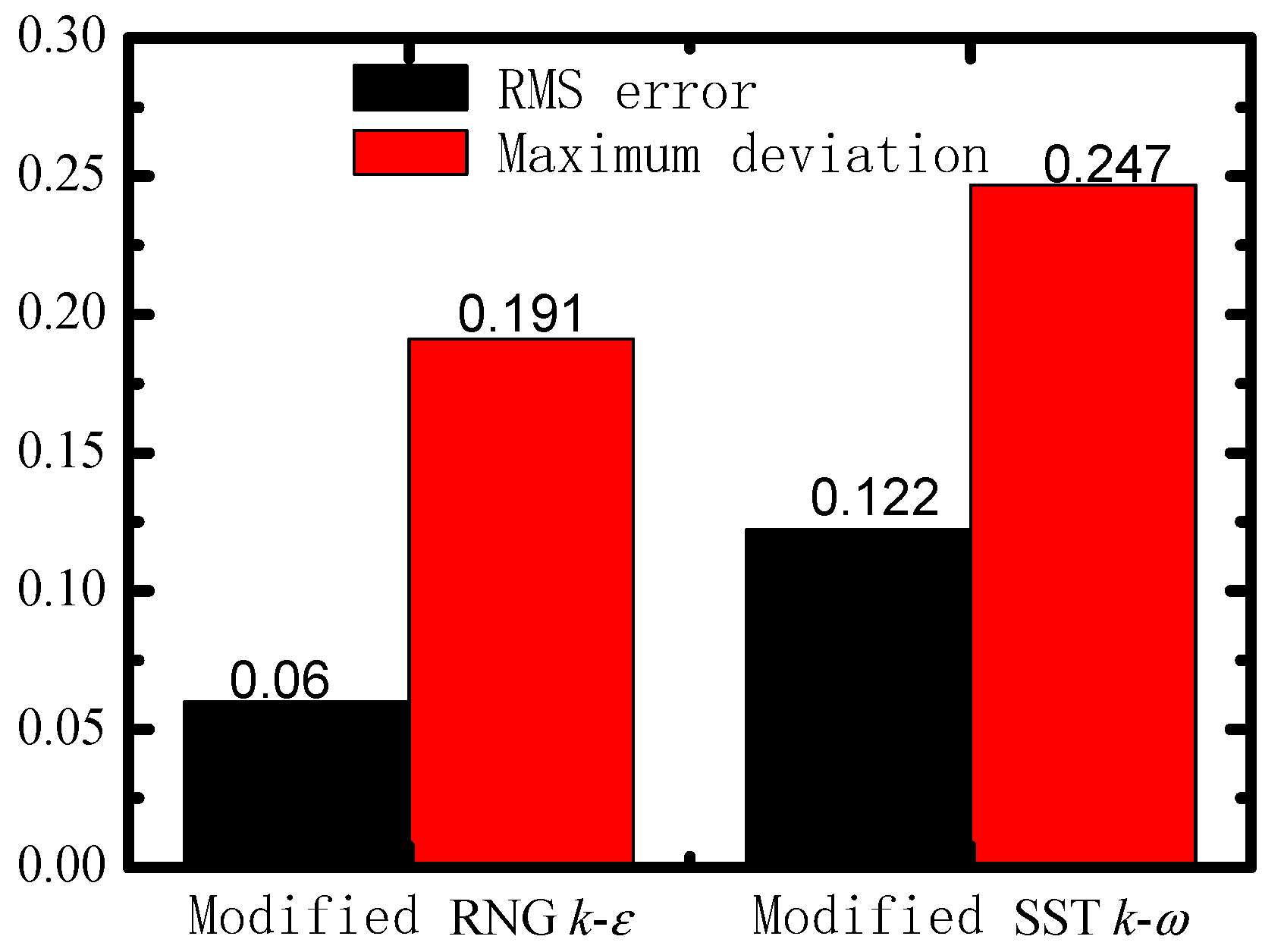

| Fluid | Temperature T∞ (K) | Inlet Speed uin (m/s) | Outlet Pressure pout (Pa) |
|---|---|---|---|
| Water | 298 (25 °C) | 8 | 51,025 |
| Water | 323 (50 °C) | 8 | 59,768 |
| Water | 343 (70 °C) | 8 | 78,110.4 |
| Mesh | Mesh Nodes | Min Angle | Max Aspect Ratio | Min Determinant | Min Quality |
|---|---|---|---|---|---|
| 1 | 1,138,840 | 46.08 | 145 | 0.794 | 0.72 |
| 2 | 2,847,100 | 46.08 | 56.1 | 0.794 | 0.72 |
| 3 | 4,555,360 | 46.08 | 34.8 | 0.794 | 0.72 |
© 2020 by the authors. Licensee MDPI, Basel, Switzerland. This article is an open access article distributed under the terms and conditions of the Creative Commons Attribution (CC BY) license (http://creativecommons.org/licenses/by/4.0/).
Share and Cite
Deng, Y.; Feng, J.; Wan, F.; Shen, X.; Xu, B. Evaluation of the Turbulence Model Influence on the Numerical Simulation of Cavitating Flow with Emphasis on Temperature Effect. Processes 2020, 8, 997. https://doi.org/10.3390/pr8080997
Deng Y, Feng J, Wan F, Shen X, Xu B. Evaluation of the Turbulence Model Influence on the Numerical Simulation of Cavitating Flow with Emphasis on Temperature Effect. Processes. 2020; 8(8):997. https://doi.org/10.3390/pr8080997
Chicago/Turabian StyleDeng, Yilin, Jian Feng, Fulai Wan, Xi Shen, and Bin Xu. 2020. "Evaluation of the Turbulence Model Influence on the Numerical Simulation of Cavitating Flow with Emphasis on Temperature Effect" Processes 8, no. 8: 997. https://doi.org/10.3390/pr8080997





